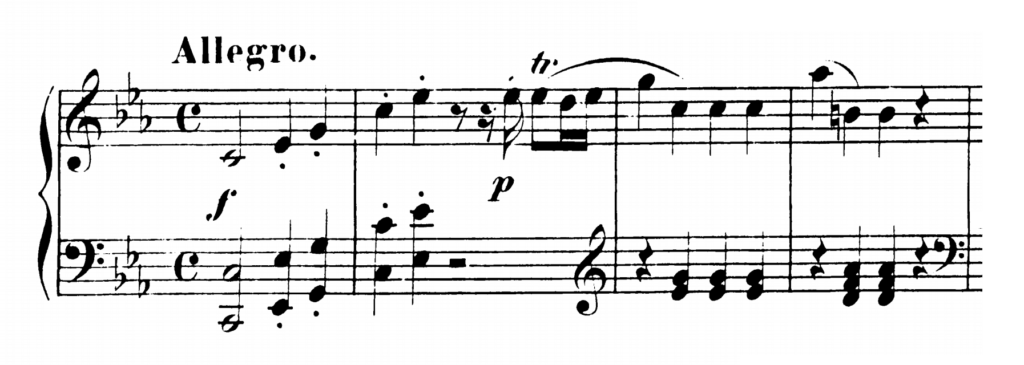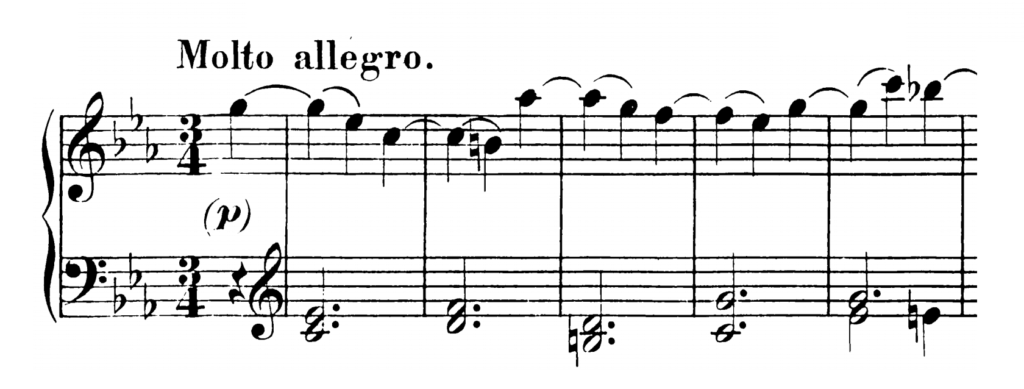Analysis
Contents
First Movement (Allegro Molto)
Form: Sonata Form. C Minor.
EXPOSITION:
Bars 1-19: First Subject in Tonic. Two points of detail to be noticed in the first subject are, that (1) Bars 9-13 are written over a dominant pedal; and (2) The upper parts in Bars 9-11 are inverted in the following bars.
Bars 19-35: Transition (overlapping). The transition overlaps the first subject, and starts with a repetition of the opening motive of this subject, taken an octave higher, followed, in Bars 21-22, by still another repetition of the same motive, taken in the bass alone and on the dominant chord in E flat major. A new melody in the latter key commences in the next bar, followed by a link which leads into the second subject in the same key.
Bars 36-71: Second Subject in E flat major (relative major). Details to be noted in the first section of the second subject (Bars 36-59) are (1) the inversion of the parts, where the hands cross, in Bars 38-39 and Bars 42-43; (2) the sequential repetition of the first phrase of the subject, Bars 40-43; and (3) the chord of the Italian sixth in F minor, which occurs both in Bars 44 and 49. A very important feature to note is that the second section of the second subject (Bars 59-71) and the second section of the second subject in the Finale of this sonata, are founded on the same motive.
Bars 71-74: Link (overlapping). This link forms an exceptional feature in these sonatas. Throughout the whole of the quick movements in this form, it is the only instance to be met with in which such a passage occurs at the end of the exposition. (Short links are, however, also to be found in the slow movements of Sonata V and XIII, both of which are written in sonata form.) It is founded on the first subject, and overlapping the last note of the second subject, it modulates in the last bar, thus leading both back to the repetition of the exposition, and onwards, into the development.
Double bar and repeat.
DEVELOPMENT:
Bars 75-99: With the exception of four bar (79-82), which reproduce in the key of F minor a portion of the melody form the transition, the development is worked entirely on the opening motive of the first subject. The section starts with this figure on the chord of C major, quitted as the dominant of F minor. In Bar 85, there is a modulation to G minor, the parts being inverted, and in Bar 89, to C minor. The development ends with an inversion of the chord of the dominant ninth (Bars 89-90).
RECAPITULATION:
Bars 100-118: First Subject in Tonic.
Bars 118-130: Transition (overlapping), shortened and altered. The transition here, as in the original passage, overlaps the first subject, with the opening figure of which it commences. The passage is shortened and modified, the melody in E flat, which occurs in the original transition (commencing Bar 23) being omitted, and a few bars of entirely new matter, in the key of D flat major, inserted in its place.
Bars 131-168: Second Subject in Tonic minor (slightly lengthened). The second subject, slightly modified, reappears in the key of the tonic, in the minor mode, however, instead of in its tonic major.
Bars 168-185: Coda (overlapping). The Coda is founded on the first subject. It starts like the link, only with inversion of the parts. The opening few bars, during which the imitation between the treble is continued, are sequential.
Second Movement (Adagio)
Form: Rondo Form. Eb Major.
PART I:
Bars 1-7: Principle Subject (first entry). As written, the principle subject is a sentence of seven bars in length, there being an elision of a bar (presumably the third) in the first half of the sentence. This is an instance, however, in which Mozart has evidently barred his movement incorrectly. If each bar, as it now appears, be divided into two, and the time this changed from four, to two, crotchets (quarter notes) in the bar, we shall find that the music is written as Mozart evidently intended it to be played. As it is now written, the subject subdivides very unusually into regular one-bar sections, each section ending on a definite cadence, the cadence itself as regularly occurring in the second, and weaker, half off the bar. When written according to the other method, the sentence subdivides into two-bar section, in each of which the cadence falls in a normal position, viz., in the second – usually the more slightly accented – of the two bars.
Bars 8-16: Episode I in B flat major (Dominant). In this melody, the sentence is prolonged by cadential repetitions from Bar 13, to Bar 16. The remainder of Bar 16 forms a link on the dominant harmony in E flat, which leads to the second entry of the principle subject. The link starts on the fourth inversion of the dominant eleventh, in which, first the major ninth gives place to the minor ninth, and then, as is so frequently to be met with, both ninth and eleventh resolve, and the root position of the dominant seventh remains.
Bars 17-23: Principle Subject (second entry), varied with ornamentation.
PART II:
Bars 24-40: Episode II, in A flat major (Subdominant), and in G flat major. This episode starts with a melody in A flat, the key of the subdominant, which modulates, and the first part ends on an inverted cadence in B flat major (Bar 31). The second part commences in G major, with a repetition of the opening bars of the above melody, followed by a modulating sequential passage, which passes through the keys of A flat minor, B flat minor, to C minor, and closes with a half-cadence. Two further bars modulate to the original key of E flat major, and lead to the third entry of the principle subject.
PART III:
Bars 41-47: Principle Subject (third entry) with further varied, and more florid, ornamentation.
Bars 47-57: Coda. The coda, founded upon the principle subject and the first episode, ends with a repetition of the concluding bars of the latter, transposed into the key of the tonic.
Third Movement (Allegro Assai)
Form: Rondo-Sonata Form. C Minor.
PART I (EXPOSITION):
Bars 1-44: Principle Subject in Tonic (first entry). The principle subject is unusually long and varied. It consists of two sections (Bar 1-16 and 16-44), each ending with a perfect cadence in the tonic. As the second of these sections itself contains two distinct musical ideas (commencing respectively in Bars 16 and 26), the subject can be described as threefold.
Bars 45-46: Link. There is no passage of transition; a single chord on the dominant seventh in E flat major, servers as a connecting link, and leads into this key, in which the second subject appears.
Bars 47-96: Second Subject in E flat major (relative major). The point of paramount importance to notice in this subject is that its second section (Bars 74-96) is founded on the same figure as the corresponding section of the second subject in the first movement of this sonata (compare with first movement, Bars 59-60, etc.). Both first and second section of the second subject are prolonged by cadential repetitions.
Bars 96-102: Link. These few bars modulate from E flat major to C minor, and form a connecting passage leading into the second entry of the principle subject.
Bars 103-145: Principle Subject in Tonic (second entry) incomplete. With Link. At this entry, on the repetition of the second section, the last phrase of the principle subject is omitted. In its place, we hear the immediately preceding figure reproduced on the chord of the diminished seventh in F minor, in which key the following episode commences.
PART II (EPISODE):
Bars 146-166: This episode is notably short. The episode occurring at this point of a sonata-rondo is usually of some length, on which account it is often known as the long episode. This one consists solely of a short passage, taken first in the key of F minor, modulating to G minor, and then repeated in G minor, modulating to C minor (the tonic), and thus leading to Part III, the recapitulation, of the movement.
PART III (RECAPITULATION):
Bars 168-220: Second Subject (in Tonic) merging towards the end into a “link-like” passage which leads into the Recapitulation of the Principle Subject. It is of interest to note at this point the construction of the movement resembles that of a movement in sonata form, in which the recapitulation of the second subject is taken irregularly before that of the first subject (compare with Sonata IX, first movement. See also Finale, in Sonata VII). Both sections (Bars 168-197 and 197-220) of the subject are somewhat lengthened, the second being also much modified towards the close. Instead of terminating for a second time on a perfect cadence in the tonic, the sentence, on being repeated, mergers half-way through into a passage based on figures from the principle subject, into the recapitulation of which subject it directly leads.
Bars 221-274: Principle Subject in Tonic (third entry) incomplete. With Link. The first section of the principle subject reappears considerably lengthened, whilst the termination of the second section is modified in similar manner to that at the previous entry. The greater part of the lengthening above mentioned, is produced by “augmentation” at the end of each little phrase in the passing marked ” a piacere,” which is based on figures from the previously heard opening bars of the principle subject. The constant pauses, in combination with the ad libitum variations of the tempo, which the above words indicate, convert the passage into somewhat of the nature of a recitative. The passing modulation to the key of the subdominant minor (Bars 234, etc.) and the chromatic supertonic triad and discords (Bars 242-245) should be noted.
Bars 275-287: Repetition of portion of Episode. The first portion of the episode, modified so as to end with a perfect cadence in C minor (the tonic), is here interpolated between the close of the principle subject and the commencement of the coda.
Bars 288-319: Coda. The coda is founded on the second subject. Bar 298 form the chord of the Neapolitan sixth in C minor.









